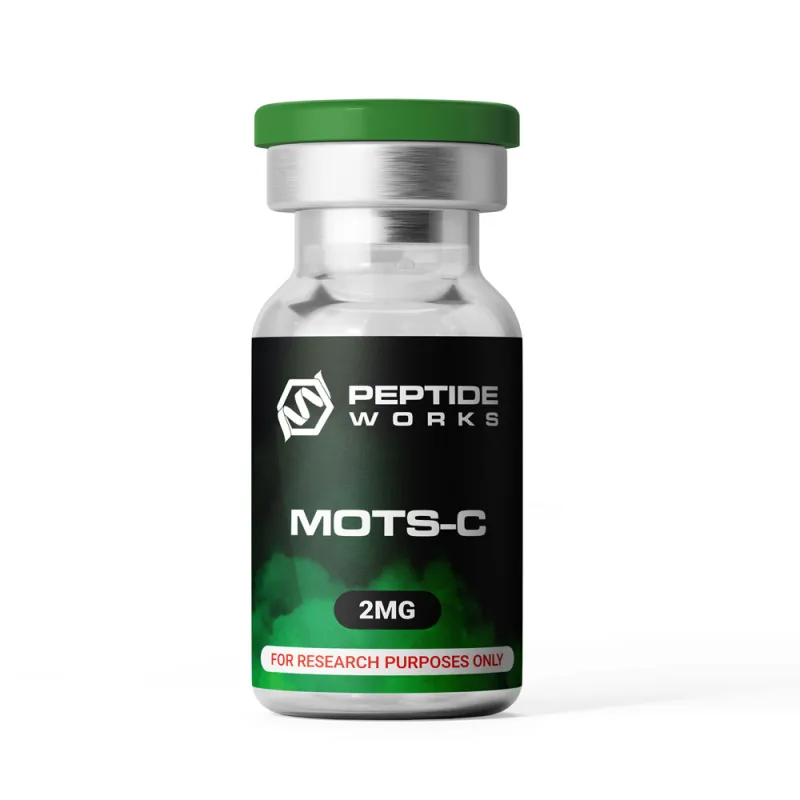Maintaining steady glucose supports sharp focus, constant energy, and leaner body-composition outcomes in laboratory settings. Among the emerging tools for regulating blood sugar, the mitochondrial peptide MOTS-c has drawn particular interest.
Studies indicate that MOTS-c flips on AMPK, the cell’s primary fuel sensor, prompting muscle tissue to absorb extra glucose from the medium without added insulin. Initial cell and rodent data report flatter post-prandial glucose curves.
Because this shift mirrors the metabolic benefits of exercise, scientists now probe MOTS-c in insulin-resistance models to map new diabetes interventions. Researchers across the globe trust Peptide Works for reliable, high-quality research peptides that make these investigations possible.
Understanding how AMPK works is useful here, since it plays a central role in blood-sugar regulation.
Explore MOTS-C from Peptide Works, a mitochondrial peptide that activates AMPK to support regulating blood sugar and metabolic balance in research models.
How Does AMPK Help Muscles Clear Extra Glucose?

AMP-activated protein kinase (AMPK) acts as the cell’s fuel gauge: when energy runs low, it flips genetic switches that funnel glucose into working muscle. One key move is driving GLUT4 transporters to the cell surface, where they double the rate of glucose uptake even without extra insulin.
AMPK also suppresses liver gluconeogenesis, keeping new sugar out of circulation, and ramps up fatty-acid oxidation, which eases lipid stress on insulin receptors and sharpens insulin sensitivity. Because the mitochondrial peptide MOTS-c directly activates AMPK in pre-clinical work, it stands out as a prime research tool for regulating blood sugar.
Since AMPK influences both glucose uptake and fat burning, the next step is to look at how fatty-acid oxidation affects blood-sugar control.
Discover AOD-9604 from Peptide Works, a research peptide that enhances fat metabolism while contributing to regulating blood sugar in experimental studies.
Does Fatty-Acid Oxidation Affect Blood-Sugar Control?
Fat-burning, called fatty-acid beta-oxidation, guides how sensitive cells are to insulin and how they use glucose. When cells burn more fat, less lipid crowds the insulin receptors, which removes the “brakes” on glucose uptake and helps blood sugar stay steadier.
In rodent studies, the peptide AOD-9604 speeds fat breakdown yet does not raise blood glucose, hinting that lower lipid load can ease insulin resistance. Humanin adds support by guarding beta cells and sharpening their insulin response, which smooths glucose curves in diabetic models. These findings suggest that targeting fat metabolism is another pathway for regulating blood sugar in research.
Researchers worldwide rely on Peptide Works for pure MOTS-c, AOD-9604, and Humanin to explore new ways to fine-tune blood-sugar control.
Beyond fat metabolism, insulin sensitivity also depends on how well pancreatic β-cells function, which leads to the question of whether Humanin can directly improve insulin sensitivity and blood-sugar regulation.
Check out Humanin from Peptide Works, a mitochondrial peptide that protects β-cells and improves insulin response in preclinical investigations.
Does Humanin Improve Insulin Sensitivity and Blood-Sugar Control?
Humanin is a small mitochondrial peptide that protects pancreatic β-cells from damage while boosting their insulin release. Unlike other metabolic signals, this 24-amino-acid molecule works through STAT3 and Akt pathways in the brain and muscle tissue.
Lab tests show Humanin injections can raise whole-body insulin sensitivity and lower blood glucose in diabetic animals. The peptide also cuts hepatic glucose production through central nervous system pathways a different approach than direct muscle activation. Research teams worldwide use high-purity Humanin to study how mitochondrial signals can improve glucose control in insulin-resistant models.
With the individual actions of MOTS-c, AOD-9604, and Humanin established, it becomes easier to compare them side by side.
Which Peptides Work Best for Insulin Sensitivity?

Three peptides stand out for boosting insulin sensitivity: MOTS-c, AOD-9604, and Humanin. Each works in different ways to help cells use insulin better for regulating blood sugar.
Comparison Table
| Peptide | Main Action | Benefit | Pathway |
|---|---|---|---|
| MOTS-c | Turns on AMPK | Helps muscles take up glucose | AMPK → GLUT4 |
| AOD-9604 | Burns fat better | Reduces stress on insulin receptors | Fatty-acid β-oxidation |
| Humanin | Guards beta cells | Boosts insulin release | STAT3, Akt |
AOD-9604 helps by burning fatty acids that can block insulin from working right. Humanin keeps pancreatic cells healthy so they make more insulin when blood sugar rises.
Since these peptides work through different paths, labs can study how they might work together for better glucose control. Peptide Works supplies research-grade MOTS-c, AOD-9604, and Humanin to help scientists explore new ways of regulating blood sugar in insulin-resistant models.
Before examining their broader benefits, it is important to consider whether these peptides cause side effects in blood-sugar research.
Do Peptides Cause Side Effects with Blood Sugar?
MOTS-c, AOD-9604, and Humanin show good safety profiles in laboratory blood sugar research. These research-grade peptides are designed for scientific studies only, not for human use. In preclinical models, mild reactions like injection site responses occur, but serious adverse events remain rare.
Severe glucose drops mainly happen when research peptides interact with other compounds in experimental settings. AOD-9604 demonstrates minimal impact on glucose levels in rodent studies, while Humanin protects pancreatic cells without major toxicity markers. Proper laboratory protocols ensure safe handling.
Alongside safety, researchers are equally interested in what these peptides may contribute outside of blood-sugar control.
What Else Can Peptides Do Beyond Regulating Blood Sugar?

Research on mitochondrial peptides such as MOTS-c and Humanin shows strong anti-inflammatory, antioxidant, and potential longevity effects. MOTS-c lowers IL-6 and other cytokines while nudging collagen synthesis, actions tied to healthier vessels and skin, two tissues often damaged in diabetes. Humanin curbs oxidative stress in nerve and retinal cells, offering a pathway to lessen neuropathy and vision loss in diabetic models.
By targeting inflammation, oxidative damage, and tissue aging, these research-grade peptides give scientists new ways to study diabetes complications. Peptide Works supplies high-purity MOTS-c and Humanin so labs can explore metabolic protection that reaches far past glucose control.
With these broad benefits in mind, the final point to consider is where this research may be heading.
The Future of Peptides in Regulating Blood Sugar
Peptides like MOTS-c, AOD-9604, and Humanin give labs a true multi-tool for regulating blood sugar. In cell and animal work, each one steadies glucose, calms inflammation, burns extra fat, and shields stressed cells, letting scientists explore many metabolic questions at once.
Larger studies are now testing safety and their “exercise-mimic” actions. Early signs suggest these tiny signals could roll organ protection and slower diabetic damage into a single, easy approach.
With high-purity batches from Peptide Works, teams can turn today’s bench data into tomorrow’s sturdy, long-lasting blood-sugar solutions.
All products discussed are supplied for research purposes only and are not intended for human use.
References
[1] Kim SJ, Miller B, Mehta HH, Xiao J, et al. The mitochondrial-derived peptide MOTS-c is a regulator of plasma metabolites and enhances insulin sensitivity. Physiol Rep. 2019 Jul;7(13):e14171.
[2] Long YC, Zierath JR. AMP-activated protein kinase signaling in metabolic regulation. J Clin Invest. 2006 Jul;116(7):1776-83.
[3] Heffernan MA, Thorburn AW, Fam B, Summers R, et al. Increase of fat oxidation and weight loss in obese mice caused by chronic treatment with human growth hormone or a modified C-terminal fragment. Int J Obes Relat Metab Disord. 2001 Oct;25(10):1442-9.
[4] Boutari C, Pappas PD, Theodoridis TD, Vavilis D. Humanin and diabetes mellitus: A review of in vitro and in vivo studies. World J Diabetes. 2022 Mar 15;13(3):213-223.
[5] Kim SJ, Guerrero N, Wassef G, Xiao J, et al. The mitochondrial-derived peptide humanin activates the ERK1/2, AKT, and STAT3 signaling pathways and has age-dependent signaling differences in the hippocampus. Oncotarget. 2016 Jul 26;7(30):46899-46912.









